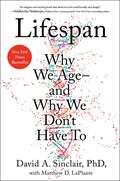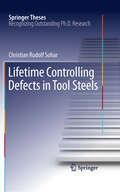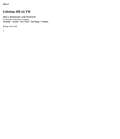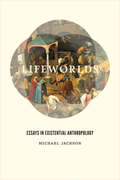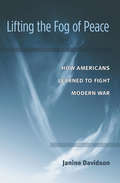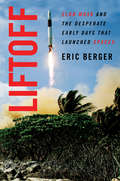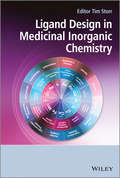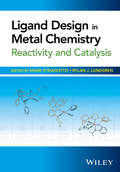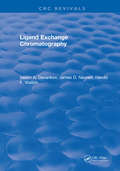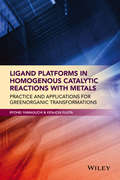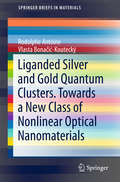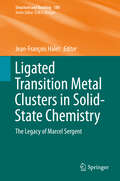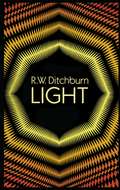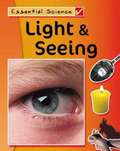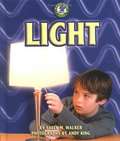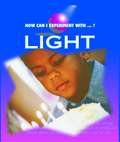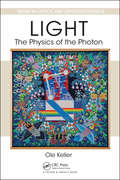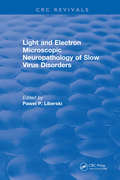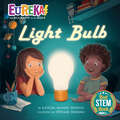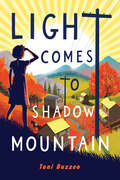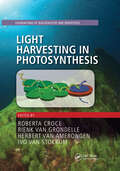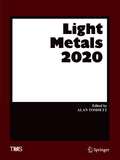- Table View
- List View
Lifespan: Why We Age—and Why We Don't Have To
by David A. Sinclair Matthew D. LaPlanteA NEW YORK TIMES BESTSELLER &“Brilliant and enthralling.&” —The Wall Street Journal A paradigm-shifting book from an acclaimed Harvard Medical School scientist and one of Time&’s most influential people.It&’s a seemingly undeniable truth that aging is inevitable. But what if everything we&’ve been taught to believe about aging is wrong? What if we could choose our lifespan? In this groundbreaking book, Dr. David Sinclair, leading world authority on genetics and longevity, reveals a bold new theory for why we age. As he writes: &“Aging is a disease, and that disease is treatable.&” This eye-opening and provocative work takes us to the frontlines of research that is pushing the boundaries on our perceived scientific limitations, revealing incredible breakthroughs—many from Dr. David Sinclair&’s own lab at Harvard—that demonstrate how we can slow down, or even reverse, aging. The key is activating newly discovered vitality genes, the descendants of an ancient genetic survival circuit that is both the cause of aging and the key to reversing it. Recent experiments in genetic reprogramming suggest that in the near future we may not just be able to feel younger, but actually become younger. Through a page-turning narrative, Dr. Sinclair invites you into the process of scientific discovery and reveals the emerging technologies and simple lifestyle changes—such as intermittent fasting, cold exposure, exercising with the right intensity, and eating less meat—that have been shown to help us live younger and healthier for longer. At once a roadmap for taking charge of our own health destiny and a bold new vision for the future of humankind, Lifespan will forever change the way we think about why we age and what we can do about it.
Lifetime Controlling Defects in Tool Steels
by Christian Rudolf SoharIn this thesis Christian Sohar describes his investigation into the gigacycle fatigue behavior of tool steels. In an interdisciplinary approach he uses knowledge and methods from a wide variety of disciplines including materials science, metallurgy, chemistry, physics and mechanical engineering. Christian gives a general introduction into steel tools and fatigue in materials. Later he extensively discusses the experimental techniques and results. Indeed it is the detail of the content in this thesis which makes it an invaluable resource for students entering the field and scientists working in related disciplines. Overall, the thesis helps us understand more about the mechanical behavior of metallic materials with complex microstructure and high hardness.
Lifeworlds: Essays in Existential Anthropology
by Michael JacksonMichael Jackson's Lifeworlds is a masterful collection of essays, the culmination of a career aimed at understanding the relationship between anthropology and philosophy. Seeking the truths that are found in the interstices between examiner and examined, world and word, and body and mind, and taking inspiration from James, Dewey, Arendt, Husserl, Sartre, Camus, and, especially, Merleau Ponty, Jackson creates in these chapters a distinctive anthropological pursuit of existential inquiry. More important, he buttresses this philosophical approach with committed empirical research. Traveling from the Kuranko in Sierra Leone to the Maori in New Zealand to the Warlpiri in Australia, Jackson argues that anthropological subjects continually negotiate imaginatively, practically, and politically their relations with the forces surrounding them and the resources they find in themselves or in solidarity with significant others. At the same time that they mirror facets of the larger world, they also help shape it. Stitching the themes, peoples, and locales of these essays into a sustained argument for a philosophical anthropology that focuses on the places between, Jackson offers a pragmatic understanding of how people act to make their lives more viable, to grasp the elusive, to counteract external powers, and to turn abstract possibilities into embodied truths.
Lifting the Fog of Peace: How Americans Learned to Fight Modern War
by Janine DavidsonHow military organizations trained for conventional war adapt—or fail to adapt—to nontraditional missions
Liftoff: Elon Musk and the Desperate Early Days That Launched SpaceX
by Eric Berger"This is as important a book on space as has ever been written and it's a riveting page-turner, too." —Homer Hickam, #1 New York Times Bestselling Author of Rocket BoysThe dramatic inside story of the historic flights that launched SpaceX—and Elon Musk—from a shaky startup into the world's leading-edge rocket companySpaceX has enjoyed a miraculous decade. Less than 20 years after its founding, it boasts the largest constellation of commercial satellites in orbit, has pioneered reusable rockets, and in 2020 became the first private company to launch human beings into orbit. Half a century after the space race it is private companies, led by SpaceX, standing alongside NASA pushing forward into the cosmos, and laying the foundation for our exploration of other worlds. But before it became one of the most powerful players in the aerospace industry, SpaceX was a fledgling startup, scrambling to develop a single workable rocket before the money ran dry. The engineering challenge was immense; numerous other private companies had failed similar attempts. And even if SpaceX succeeded, they would then have to compete for government contracts with titans such as Lockheed Martin and Boeing, who had tens of thousands of employees and tens of billions of dollars in annual revenue. SpaceX had fewer than 200 employees and the relative pittance of $100 million in the bank.In Liftoff, Eric Berger, senior space editor at Ars Technica, takes readers inside the wild early days that made SpaceX. Focusing on the company’s first four launches of the Falcon 1 rocket, he charts the bumpy journey from scrappy underdog to aerospace pioneer. We travel from company headquarters in El Segundo, to the isolated Texas ranchland where they performed engine tests, to Kwajalein, the tiny atoll in the Pacific where SpaceX launched the Falcon 1. Berger has reported on SpaceX for more than a decade, enjoying unparalleled journalistic access to the company’s inner workings. Liftoff is the culmination of these efforts, drawing upon exclusive interviews with dozens of former and current engineers, designers, mechanics, and executives, including Elon Musk. The enigmatic Musk, who founded the company with the dream of one day settling Mars, is the fuel that propels the book, with his daring vision for the future of space. Filled with never-before-told stories of SpaceX’s turbulent beginning, Liftoff is a saga of cosmic proportions.
Ligand Design in Medicinal Inorganic Chemistry
by Tim StorrIncreasing the potency of therapeutic compounds, while limiting side-effects, is a common goal in medicinal chemistry. Ligands that effectively bind metal ions and also include specific features to enhance targeting, reporting, and overall efficacy are driving innovation in areas of disease diagnosis and therapy.Ligand Design in Medicinal Inorganic Chemistry presents the state-of-the-art in ligand design for medicinal inorganic chemistry applications. Each individual chapter describes and explores the application of compounds that either target a disease site, or are activated by a disease-specific biological process.Ligand design is discussed in the following areas:Platinum, Ruthenium, and Gold-containing anticancer agentsEmissive metal-based optical probesMetal-based antimalarial agentsMetal overload disordersModulation of metal-protein interactions in neurodegenerative diseasesPhotoactivatable metal complexes and their use in biology and medicineRadiodiagnostic agents and Magnetic Resonance Imaging (MRI) agentsCarbohydrate-containing ligands and Schiff-base ligands in Medicinal Inorganic ChemistryMetalloprotein inhibitorsLigand Design in Medicinal Inorganic Chemistry provides graduate students, industrial chemists and academic researchers with a launching pad for new research in medicinal chemistry.
Ligand Design in Metal Chemistry: Reactivity and Catalysis
by Stephen L. Buchwald Mark Stradiotto Rylan J. Lundgren David MilsteinThe design of ancillary ligands used to modify the structural and reactivity properties of metal complexes has evolved into a rapidly expanding sub-discipline in inorganic and organometallic chemistry. Ancillary ligand design has figured directly in the discovery of new bonding motifs and stoichiometric reactivity, as well as in the development of new catalytic protocols that have had widespread positive impact on chemical synthesis on benchtop and industrial scales. Ligand Design in Metal Chemistry presents a collection of cutting-edge contributions from leaders in the field of ligand design, encompassing a broad spectrum of ancillary ligand classes and reactivity applications. Topics covered include: * Key concepts in ligand design* Redox non-innocent ligands* Ligands for selective alkene metathesis* Ligands in cross-coupling * Ligand design in polymerization* Ligand design in modern lanthanide chemistry* Cooperative metal-ligand reactivity* P,N Ligands for enantioselective hydrogenation* Spiro-cyclic ligands in asymmetric catalysis This book will be a valuable reference for academic researchers and industry practitioners working in the field of ligand design, as well as those who work in the many areas in which the impact of ancillary ligand design has proven significant, for example synthetic organic chemistry, catalysis, medicinal chemistry, polymer science and materials chemistry.
Ligand Exchange Chromatography
by Vadim A. DavankovThis book presents a systematic and comprehensive review of the information on chromatographic processes that involve the formation of coordination compounds, aiming not only to demonstrate the achievements that have been made in the theory of praxis of chromatography, but also to point out, as far as possible, the future of potential of ligand exchange chromatography.
Ligand Platforms in Homogenous Catalytic Reactions with Metals: Practice and Applications for Green Organic Transformations
by Ryohei Yamaguchi Ken-ichi FujitaServing as a user's manual for synthetic organic and catalytic chemists, this book guides chemists in the design and choice of ligands to catalyze organic reactions and apply the results for more efficient, green, and practical synthesis. • Focuses on the role of ligands in metal complexes that catalyze green organic transformations: a hot topic in the area of organic synthesis and green chemistry • Offers a comprehensive resource to help readers design and choose ligands and understand selectivity/reactivity characteristics • Addresses a gap by taking novel ligand approaches and including up-to-date discussion on hydrogen transfers and reactions • Presents important industrial perspective and provides rational explanations of ligand effects, impacts, and novelty
Liganded silver and gold quantum clusters. Towards a new class of nonlinear optical nanomaterials (SpringerBriefs in Materials)
by Rodolphe Antoine Vlasta Bonačić-KouteckýMetallic quantum clusters belonging to intermediate size regime between two and few hundred of atoms, represent unique building blocks of new materials. Nonlinear optical (NLO) characteristics of liganded silver and gold quantum clusters reveal remarkable features which can be tuned by size, structure and composition. The two-photon absorption cross sections of liganded noble metal quantum clusters are several orders of magnitude larger than that of commercially-available dyes. Therefore, the fundamental photophysical understanding of those two-photon processes in liganded clusters with few metal atoms deserve special attention, in particularly in context of finding the mechanisms responsible for these properties. A broad range of state-of-the-art experimental methods to determine nonlinear optical properties (i.e. two-photon absorption, two-photon excited fluorescence and second harmonic generation) of quantum clusters are presented. The experimental setup and underlying physical concepts are described. Furthermore, the theoretical models and corresponding approaches are used allowing to explain the experimental observations and simultaneously offering the possibility to deduce the key factors necessary to design new classes of nanoclusters with large NLO properties. Additionally, selected studied cases of liganded silver and gold quantum clusters with focus on their NLO properties will be presented as promising candidates for applications in imaging techniques such as fluorescence microscopy or Second-Harmonic Generation microscopy.
Ligated Transition Metal Clusters in Solid-state Chemistry: The legacy of Marcel Sergent (Structure and Bonding #180)
by Jean-François HaletThis volume dedicated to the memory of Marcel Sergent who was a leader in this field for many years, addresses past achievements and recent developments in this vibrant area of research. Large classes of ligated transition metal clusters are produced either exclusively or most reliably by means of high-temperature solid-state reactions. Among them, the Chevrel-Sergent phases and related materials have generated enormous interest since their discovery in 1971. Today, these materials and their numerous derivatives still constitute a vivid area of research finding some applications not only in superconductivity, but also in catalysis, optics or thermoelectricity to mention a few.
Light
by Tammy Jones Margie Burton Cathy FrenchThis book is about sources of light such as the sun, stars, and fire.
Light
by R. W. DitchburnThis classic study, available for the first time in paperback, clearly demonstrates how quantum theory is a natural development of wave theory, and how these two theories, once thought to be irreconcilable, together comprise a single valid theory of light. Aimed at students with an intermediate-level knowledge of physics, the book first offers a historical introduction to the subject, then covers topics such as wave theory, interference, diffraction, Huygens' Principle, Fermat's Principle, and the accuracy of optical measurements. Additional topics include the velocity of light, relativistic optics, polarized light, electromagnetic theory, and the quantum theory of radiation. The more difficult mathematics has been placed in appendixes, or in separated paragraphs in small type, intended to be omitted on first reading. Examples and/or references follow each chapter to assist the student in absorbing the material and to suggest additional resources.
Light & Seeing (Essential Science)
by Peter RileyEssential Science is a series of sound science reference books, written by an award-winning author. In 'Light & Seeing' we explore what light is, how it travels and how we see and process it through a stimulating combination of information and hands-on investigation.
Light (How Can I Experiment With...?)
by Cindy Devine DaltonThe "How Can I Experiment With...?" answers many interesting questions. In this book, we consider light. Do you know what would happen if you could fly in a spacecraft at the speed of light? Other books in this series are available in this library. What is light made of? Why does it hurt your ears when someone scratches a chalkboard? Why do you always fall down--and not up? This series takes you on a journey from the inside of a tiny atom to the outer reaches of space. Try out the hands-on experiments inside so you can see for yourself how gravity, sound, simple machines, and more work. If you're learning about physical sciences in school, these books are a great way to go in-depth, or to get ahead!
Light - The Physics of the Photon (Series in Optics and Optoelectronics)
by Ole KellerFrom the early wave-particle arguments to the mathematical theory of electromagnetism to Einstein's work on the quantization of light, different descriptions of what constitutes light have existed for over 300 years. Light - The Physics of the Photon examines the photon phenomenon from several perspectives. It demonstrates the importance of studyin
Light And Electron Microscopic Neuropathology of Slow Virus Disorders
by P. P. LiberskiLight and Electron Microscopic Neuropathology of Slow Virus Disorders provides extensive coverage of the neurobiology and neuropathology of slow, unconventional virus disorders also known as prion diseases. The book features an outstanding group of contributers, including Nobel Laureate Dr. D. Carleton Gajdusek and his co-workers. Studies range from the classical to the modern and are based on light microscopy, electron microscopy, and immunohistochemistry. Specific topics covered include spongiform encephalopathies and the hypothesis of infectious polypeptides, structure of the agent, neuropathology of kuru, Creutzfeldt-Jakob disease, Gerstmann-Str‘sler-Scheinker diseases, scrapie, bovine spongiform encephalopathy, and chronic wasting disease. Many chapters are based on findings from over 15,000 unpublished micrographs from cases and experimental models. The book also features an extensive list of references ranging from classic 19th century studies to studies through mid-1992. Light and Electron Microscopic Neuropathology of Slow Virus Disorders will be an excellent reference for neurologists, neuropathologists, virologists, neurobiologists, and other scientists interested in these virus disorders.
Light And Sound Energy Waves
by Rebecca L. JohnsonLight and sound are waves of moving energy. Light is a form of energy you can see. Light waves travel in straight lines away from a light source. Sound is a form of energy you can hear. Sound happens when particles of matter vibrate. Properties of light and sound waves include wavelength, frequency, and amplitude.
Light And Sound: Color And Sound All Around
by Rebecca L. JohnsonLight waves are transverse. Their properties include wavelength, frequency, and amplitude. Light waves can be absorbed, reflected, or refracted. An object's color depends on the colors of white light it absorbs and reflects. Sound travels through matter as compression waves. The frequency and amplitude of sound waves are related to the pitch and volume of sounds.
Light Bulb: Eureka! The Biography of an Idea (Eureka! The Biography of an Idea)
by Kathleen Weidner ZoehfeldElectric lights--without them, we'd be in the dark! Here is a "biography" of the light bulb, an essential invention that lights up our days and nights.From the first spark of Thomas Alva Edison's idea to the spread of electric lights around the world, Light Bulb is a fun and informative look at an invention that makes a huge difference in our lives. This STEAM nonfiction title is part of the new Eureka! series, each book covering one groundbreaking, world-changing discovery that millions of people use every single day.
Light Comes to Shadow Mountain
by Toni BuzzeoCora Mae Tipton is determined to light up her Appalachian community in this historical fiction novel from an award-winning author and former librarian.It&’s 1937 and the government is pushing to bring electricity to the mountains of southeastern Kentucky. It&’s all Cora can think of; radios with news from around the world, machines that keep food cold, lightbulbs by which to read at night! Cora figures she can help spread the word by starting a school newspaper and convincing her neighbors to support the Rural Electrification Act.But resistance to change isn&’t easy to overcome, especially when it starts at home. Cora&’s mother is a fierce opponent of electrification. She argues that protecting the landscape of the holler—the trees, the streams, the land that provides for their way of life—is their responsibility. But Cora just can&’t let go of wanting more. Lyrical, literary, and deeply heartfelt, this debut novel from an award-winning author-librarian speaks to family, friendship, and loss through the spirited perspective of a girl eager for an electrified existence, but most of all, the light of her mother&’s love and acceptance.Back matter includes an Author&’s Note; further information on the Rural Electrification Act, the herbs and plants of Appalachia, the Pack Horse Library Project, and more; and a &“Quick Questions&” historical trivia section for readers.A Junior Library Guild Gold Standard Selection
Light Harvesting in Photosynthesis (Foundations of Biochemistry and Biophysics)
by Rienk Van Grondelle Roberta Croce Herbert Van Amerongen Ivo Van StokkumThis landmark collective work introduces the physical, chemical, and biological principles underlying photosynthesis: light absorption, excitation energy transfer, and charge separation. It begins with an introduction to properties of various pigments, and the pigment proteins in plant, algae, and bacterial systems. It addresses the underlying physics of light harvesting and key spectroscopic methods, including data analysis. It discusses assembly of the natural system, its energy transfer properties, and regulatory mechanisms. It also addresses light-harvesting in artificial systems and the impact of photosynthesis on our environment. The chapter authors are amongst the field’s world recognized experts.Chapters are divided into five main parts, the first focused on pigments, their properties and biosynthesis, and the second section looking at photosynthetic proteins, including light harvesting in higher plants, algae, cyanobacteria, and green bacteria. The third part turns to energy transfer and electron transport, discussing modeling approaches, quantum aspects, photoinduced electron transfer, and redox potential modulation, followed by a section on experimental spectroscopy in light harvesting research. The concluding final section includes chapters on artificial photosynthesis, with topics such as use of cyanobacteria and algae for sustainable energy production.
Light Metals 2020 (The Minerals, Metals & Materials Series)
by Alan TomsettThe Light Metals symposia at the TMS Annual Meeting & Exhibition present the most recent developments, discoveries, and practices in primary aluminum science and technology. The annual Light Metals volume has become the definitive reference in the field of aluminum production and related light metal technologies. The 2020 collection includes papers from the following symposia: • Alumina and Bauxite• Aluminum Alloys, Processing and Characterization• Aluminum Reduction Technology• Cast Shop Technology• Cast Shop Technology: Recycling and Sustainability Joint Session• Electrode Technology for Aluminum Production
